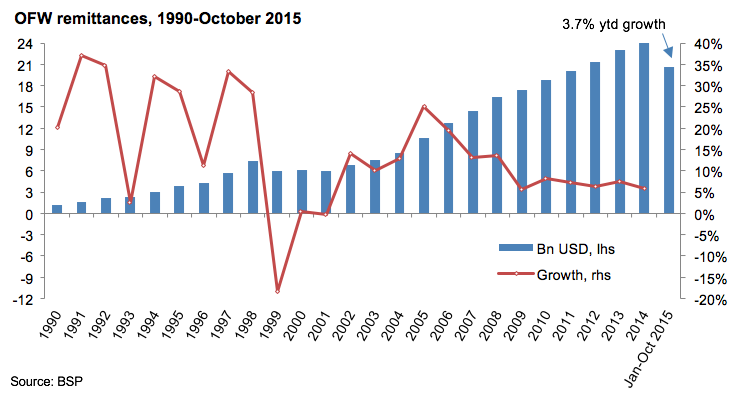Remittances Are Important But Distort the Economy
Remittances from the nearly 10 million Filipinos abroad13 are the biggest change of the past decade in the Philippine economy and are likely to have ever-increasing importance in the years ahead. Remittances from Filipinos working abroad have become the economy’s second largest source of foreign capital and may eventually exceed the size of the largest source, the local value-added of exports. They have created an underlying floor for the economy that some economists believe accounts for about 4% annual economic growth and shielded the conservative Philippine elite from pressure to reform the status quo. The Philippines in 2009 was the world’s fourth highest recipient of remittances from nationals, trailing only India (US$ 49 billion), China (US$ 48 billion), and Mexico (US$ 22 billion).14
Global demographic trends favor the Philippines. Its young, fast-growing population provides a large and growing labor pool for both domestic and overseas employment, so long as education is improved to provide the next generation entering the workforce with skills equivalent to their parents. During the last 9 years remittances increased 187 percent from US$ 6 billion in 2001 to US$ 17.35 billion in 2009 (see Figure 17). Predictions made in early 2009 that remittances would decline as much as 10% as substantial numbers of Overseas Filipino Workers (OFWs) lost jobs abroad and returned home proved to be inaccurate. By the end of 2009, remittances had increased by 5.65% year-on-year and Filipino workers abroad were often retained in preference to more expensive employees of other nationalities. In the first eight months of 2010 remittances grew 7.4% year-on-year.
“The Philippines has still never unleashed the full economic potential of its creative people thanks to multiple government barriers and corruption. Too many of its young people feel they must seek opportunity abroad.”
—Asian Wall Street Journal editor, August 3, 2009
Foreign labor markets in wealthy countries with aging populations (Europe, Japan, Korea, Taiwan) or labor shortages (Canada, Middle East, US) are expected to remain open and welcoming to Filipinos. A recent and optimistic projection of remittance growth by Albay Governor Joey Salceda, an economic advisor to Philippine presidents, predicted remittances would reach US$ 42 billion by 2015 and approach 20% of GDP, a doubling of their current 10% of GDP (see Table 4). His projection assumes remittance growth rates for the next six years (2010-2015) will be very similar to the last six years (2004-2009). Such a huge increase in inward capital flows warrants serious study of their potential effects on the economy (e.g. on appreciating the peso) and how they can be captured and channeled into needed investment (e.g. bonds for infrastructure).
Footnotes




























